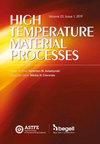压缩等离子体流冲击对Ti-6Al-4V钛合金表面变形的影响
IF 0.6
Q4 MATERIALS SCIENCE, MULTIDISCIPLINARY
引用次数: 0
摘要
研究了压缩等离子体流动对Ti-6Al-4V钛合金表面起伏的影响。研究方法包括轮廓术、x射线衍射、扫描电镜和样品重量测量等。结果表明,等离子体撞击由于熔体-等离子体边界流体动力不稳定性的作用,导致表面起伏较大(Ra参数在0.7 ~ 2.7µm范围内发生变化)。脉冲数的增加导致Ra值的增大。在不可压缩流体势流模型的基础上,对等离子体冲击下的表面演化进行了数值模拟。模拟数据与实验数据集相关联。等离子体撞击过程中熔体的流体动力流动导致了另一个过程——表面侵蚀。吸收能量密度和脉冲数的增加导致侵蚀强度增加。氮(作为等离子体产生气体)与在等离子体冲击下加热的表面相互作用,在表面上形成氮化钛。氮化钛薄膜阻止了由水动力不稳定性作用形成的表面起伏的发展。本文章由计算机程序翻译,如有差异,请以英文原文为准。
Modification of Ti-6Al-4V titanium alloy surface relief by compression plasma flows impact
Investigation of compression plasma flows impact on surface relief of Ti-6Al-4V titanium alloy was carried out in this work. Profilometry, X-ray diffraction, scanning electron microscopy and samples weight measurements were used as investigation techniques. The findings showed that plasma impact led to the formation of developed surface relief (Ra parameter was changed in the range of 0.7-2.7 µm) due to the action of hydrodynamic instabilities at the melt-plasma border. Increase in the number of pulses resulted in the growth of Ra value. Numerical simulation of surface evolution under plasma impact was carried out on the basis of the model of incompressible fluid potential flow. Simulation data correlated with experimental data set. The hydrodynamic flow of the melt during plasma impact led to another process - surface erosion. Increase in both the absorbed energy density and the number of pulses resulted in erosion intensity increase. Formation of titanium nitride on the surface was observed as a result of the interaction of nitrogen (as a plasma generating gas) with the surface heated under plasma impact. Titanium nitride film prevented the development of the surface relief formed by the action of hydrodynamic instabilities.
求助全文
通过发布文献求助,成功后即可免费获取论文全文。
去求助
来源期刊

High Temperature Material Processes
工程技术-材料科学:综合
CiteScore
1.20
自引率
25.00%
发文量
31
期刊介绍:
High Temperature Material Processes is an important international publication devoted to original and invited review papers on fundamental and applied re-search and new developments in materials processing and synthesis at high temperatures, especially under the plasma action as well as the treatment by laser, ion and electron beams. Processes of interest include (but not limited to) surface treatments, alloying, coatings production, nanostructures synthesis, welding, cutting, melting, re-melting and purification of metals, metallurgy (among them plasma metallurgy), powder densification, ultra-fine powder production, waste conversion and destruction. In addition, attention is paid to the development, description and study of experimental and industrial systems and devices for the implementation of high-technology plasma and beam processes. Thus, there is a broad range of coverage of experimental, analytical and numerical studies. High Temperature Material Processes will serve the needs of those who develop high temperature processes to produce materials with improved properties, surface treatments or coatings with given specifications, and will also promote connections between laboratories and industry.
 求助内容:
求助内容: 应助结果提醒方式:
应助结果提醒方式:


